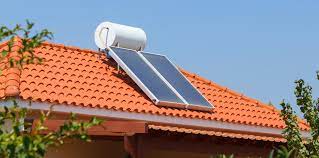If you own a home in Australia you have experienced chilly winters and scorching hot summers, but whatever the weather may be outside, you want to rely on having a hot shower and plenty of hot water to do the washing. The country gets plenty of sun no matter what time of year it is, so why not put all that free energy from the sky to work for you? Thanks to great new advances in technology it’s easy these days to have a solar hot water system installed in your home! You will be able to enjoy the abundant sunshine with a continuous supply of hot water at a fraction of the cost of gas or grid electricity!
Reduced water and power bills, clean, green energy, and a ready supply of heating water provided by the sun’s energy are some of the great reasons why solar water heaters are quickly becoming a popular alternative. Expert manufacturers like Rheem Water Heaters offer a variety of excellent solar-powered water heaters and will make sure yours is installed correctly so that you can begin to enjoy the benefits of a sustainable hot water system powered by the sun!
If you are still wondering if a solar hot-water heater is the right choice for your home, let’s learn some more about them! There are numerous designs available on the market, but all solar water heaters are comprised of a solar collector and a storage tank that are used to absorb the thermal energy provided by the sun to heat your water.
Solar water heaters are generally divided into two categories, active and passive, with each working a bit differently and using somewhat different equipment.
Active Solar Water Heating Systems – There are two versions of this system:
- The direct circulating system uses pumps to circulate water through the solar collectors placed above, usually on your roof, then back into your house to fill the tank with the heated water. These work best in climates that are not subject to temperatures that fall below freezing.
- The indirect circulating system once again uses pumps, but this time to circulate a non-freezing heat-transfer liquid through the collectors, then through a heat exchanger that warms the potable water that fills your water tank. This type of system is useful for environments where freezing temperatures occur.
Passive Solar Water Heating Systems – These systems are able to store water for use on cold and cloudy days without adequate sun, but there is the possibility you could use up all your heated water if there is a long spell of foul weather. Passive systems are still quite dependable overall, are less expensive, and tend to last longer than active systems. There are two different kinds to choose from:
- The integral collector-storage passive system uses ultraviolet rays to heat the water, utilizing a transparent cover over the storage tank that moves the water with a plumbing system. This one is best in areas that don’t freeze over.
- The thermosyphon system tells the roof collector to send heated water flowing into the plumbing system when the hot water tap is turned on.
Australia is dedicated to moving to a sustainable future, so go solar!
Write and Win: Participate in Creative writing Contest & International Essay Contest and win fabulous prizes.

















